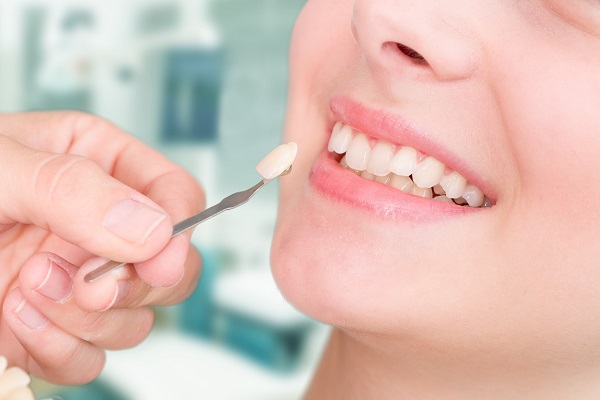Dental Veneers to Fix a Gap Between Teeth

Porcelain veneers and porcelain laminates are other names for dental veneers. These are tooth-colored, thin, custom-made casings dentists apply to the visible part of one’s teeth. The purpose of which is to make the teeth appear more appealing. These laminates are bonded to one’s teeth.
And since they are connected, they also have better length, color, and shape. On top of that, these laminates can also help remove gaps in between teeth. They are made of composite resin and porcelain materials. Porcelain can mimic the natural teeth’s appearance and resist stains. The dentist can help the patient decide the suitable laminates fit for them.
Who should get plastic laminates?
One of the primary purposes of plastic laminates is to improve one’s teeth appearance. Ideally, it is great for people with teeth that are uneven or crooked or who have unwanted gaps. Veneers can also be used for cracked, chipped, or worn-down teeth. This is a good idea for teeth that may have undesirable shapes like cratering or bulging. Dentists also use veneers for teeth that have been permanently discolored due to excessive fluoride use, tetracycline use, previous root canal, and other conditions.
What are the upsides of wearing veneers?
Plastic laminates and dental crowns serve the same purpose. However, the latter is more invasive. So, between the two, the better option for those not wanting anything invasive is plastic laminates. Here are the advantages of these plastic laminates:
- Durable and strong – could last up to 15 or more years
- Matches the color of the areas surrounding one’s teeth
- Resistant to stain
- Diminishes unwanted gaps
- Does not affect one’s gum tissues
- Natural appearance of the teeth
What are the processes involved in getting plastic laminates?
The first step is the initial visit. At this time, the dentist will ask about the patient’s goals for having plastic laminates. The dentist can advise if the patient is a candidate for this by taking both tooth X-rays and impressions. If, after the initial dental visit, the patient is advised to have plastic laminates, then the next visit would be the preparation visit. This time, the dentist might need to remove at least one-half millimeter of the patient’s enamel from the surface of that tooth that will be getting plastic laminates.
After this, the dentist will have to make a teeth impression to be sent to the veneer-creating dental laboratory. It could take at least two weeks to a month before one’s plastic laminates could be made. Once these laminates are sent to the dentist, the patient must prepare for the final visit. The third plastic laminate-related visit will be devoted to applying the laminates. This time, the dentist will be examining the laminates to see if it fits on the patient’s teeth and if the colors are proper. During this time, adjustments are made to ensure that the patient is only getting the right laminate.
Once the plastic laminates are placed, the dentist will clean, polish, and etch them. The last step is essential to ensure that one’s plastic laminates will fit. The tooth is given a rough exterior by etching, thereby promoting a stronger bond with the plastic laminate. After achieving the right shape and location of the plastic laminates, the dentist will then bond it with the use of a special light activated by a chemical reaction.
After laminate placement
Follow-up checkups with the dentist are necessary. The dentist will check how the laminate veneers are functioning with the gums. Cleaning the teeth and gums is necessary to keep the veneers and natural teeth in good health for decades. Seeing the dentist before a long-distance trip can keep the shells bright and white for a while.
Hard brushing can leave abrasions on the shells. This will make them prone to damage and staining. Using non-abrasive dental products and a soft-bristled toothbrush can clean the laminates without scratching them. Rinsing with alcohol-free mouthwash can protect the teeth while keeping the shells in place. Wearing a nightguard while sleeping can protect the shells from the pressures of teeth grinding or jaw clenching.
More about laminates
It takes two dental visits to complete a laminate treatment. This will ensure a correct laminate fit for each affected tooth. For regular veneers, the front surface of teeth will need some shaving off. Most laminate treatments do not need this. The shells are so thin that the dentist can apply some etching solution to the surfaces of teeth and apply the shells.
Try veneers today
Dental veneers can help you improve your oral health. Talk to your dentist to figure out the right option for you. Improve your smile with the plastic laminates. You can make all these pleasant changes if you choose to visit your dentist.
Are you considering getting veneers in the Gainesville area? Get more information at https://gallodental.com.
Check out what others are saying about our dental services on Yelp: Dental Veneers in Gainesville, GA.
Recent Posts
Dental veneers are a popular cosmetic dentistry solution that can transform the appearance of your smile. These thin, custom-made shells cover the front surface of teeth, addressing issues such as discoloration, chips, gaps, and minor misalignments. Dental veneers offer a minimally invasive way to achieve a natural, radiant smile, making them an excellent choice for…
Dental veneers have become an increasingly popular choice for patients looking to improve the appearance of their smiles. A veneer can enhance the color and shape of your teeth, providing a more uniform and aesthetically pleasing smile. However, they are not a one-size-fits-all solution; certain factors determine whether someone is a good candidate. Patients should…
Dental veneers, artificial shells that go over teeth, can improve your smile in many ways, from concealing irremovable stains to filling in gaps between teeth. Some procedures are only to change the appearance of a smile, while others can also provide a stronger defense against oral issues and infections. Whatever a patient’s personal needs, it…
Veneers are artificial shells placed over natural teeth to conceal damage, such as discoloration or chips. Patients often invest in this type of dental restoration to create whole, even smiles that foster self-confidence. When considering any treatments to improve a smile, many patients want solutions that last. For many patients, veneers can offer a long-lasting…


